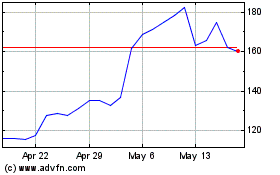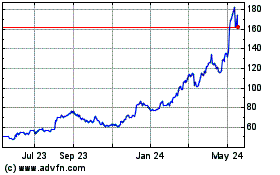IES Holdings, Inc. (or “IES” or the “Company”) (NASDAQ: IESC) today
announced that it has amended and restated its existing Credit and
Security Agreement, increasing the commitment amount of the
revolving credit facility to $300 million from $150 million and
extending the maturity date to January 21, 2030 while expanding the
size of the lending group. In addition, the amended credit
agreement transitions the Company to a cash flow-based facility,
enabling increased borrowing capacity compared to the previous
asset-based structure, where availability was limited by eligible
collateral. Wells Fargo Bank, National Association acted as
Administrative Agent, Wells Fargo Securities, LLC acted as Left
Lead Arranger and Joint Bookrunner, and Fifth Third Bank, National
Association acted as Joint Lead Arranger and Joint Bookrunner.
Jeff Gendell, IES’s Chairman and Chief Executive
Officer, said, “We appreciate the confidence that Wells Fargo,
Fifth Third and our new banking partners have shown in IES through
this larger and more flexible credit facility. This facility
strengthens our ability to execute on our capital allocation
strategy by providing us the liquidity and flexibility to pursue
our strategic priorities, including organic growth, acquisitions,
share repurchases and other investment opportunities.”
About IES Holdings, Inc.
IES designs and installs integrated electrical
and technology systems and provides infrastructure products and
services to a variety of end markets, including data centers,
residential housing, and commercial and industrial facilities. Our
more than 9,000 employees serve clients in the United States. For
more information about IES, please visit www.ies-co.com.
Company Contact:
Tracy McLauchlinChief Financial OfficerIES Holdings, Inc.(713)
860-1500
Investor Relations Contact:
Robert Winters or Stephen PoeAlpha IR
Group312-445-2870IESC@alpha-ir.com
Certain statements in this release may be deemed
“forward-looking statements” within the meaning of Section 27A of
the Securities Act of 1933 and Section 21E of the Securities
Exchange Act of 1934, all of which are based upon various estimates
and assumptions that the Company believes to be reasonable as of
the date hereof. In some cases, you can identify forward-looking
statements by terminology such as “may,” “will,” “could,” “should,”
“expect,” “plan,” “project,” “intend,” “anticipate,” “believe,”
“seek,” “estimate,” “predict,” “potential,” “pursue,” “target,”
“continue,” the negative of such terms or other comparable
terminology. These statements involve risks and uncertainties that
could cause the Company’s actual future outcomes to differ
materially from those set forth in such statements. Such risks and
uncertainties include, but are not limited to, a general reduction
in the demand for our products or services; changes in general
economic conditions, including supply chain constraints, high rates
of inflation, changes in consumer sentiment, elevated interest
rates, and market disruptions resulting from a number of factors,
including geo-political events; competition in the industries in
which we operate, which could result in the loss of one or more
customers or lead to lower margins on new projects; our ability to
successfully manage and execute projects, the cost and availability
of qualified labor and the ability to maintain positive labor
relations, and our ability to pass along increases in the cost of
commodities used in our business; supply chain disruptions due to
our suppliers' access to materials and labor, their ability to ship
products timely, or credit or liquidity problems they may face;
inaccurate estimates used when entering into fixed-price contracts,
the possibility of errors when estimating revenue and progress to
date on percentage-of-completion contracts, and complications
associated with the incorporation of new accounting, control and
operating procedures; our ability to enter into, and the terms of,
future contracts; the existence of a small number of customers from
whom we derive a meaningful portion of our revenues; reliance on
third parties, including subcontractors and suppliers, to complete
our projects; the inability to carry out plans and strategies as
expected, including the inability to identify and complete
acquisitions that meet our investment criteria, or the subsequent
underperformance of those acquisitions; challenges integrating new
businesses into the Company or new types of work, products or
processes into our segments; backlog that may not be realized or
may not result in profits; failure to adequately recover on
contract change orders or claims against customers; closures or
sales of our facilities resulting in significant future charges or
a significant disruption of our operations; the impact of future
epidemics or pandemics on our business; an increased cost of surety
bonds affecting margins on work and the potential for our surety
providers to refuse bonding or require additional collateral at
their discretion; the impact of seasonality, adverse weather
conditions, and climate change; fluctuations in operating activity
due to factors such as cyclicality, downturns in levels of
construction or the housing market, and differing regional economic
conditions; difficulties in managing our billings and collections;
accidents resulting from the physical hazards associated with our
work and the potential for accidents; the possibility that our
current insurance coverage may not be adequate or that we may not
be able to obtain policies at acceptable rates; the effect of
litigation, claims and contingencies, including warranty losses,
damages or other latent defect claims in excess of our existing
reserves and accruals; costs and liabilities under existing or
potential future laws and regulations, including those laws and
regulations related to the environment and climate change, as well
as the inability to transfer, renew and obtain electrical and other
professional licenses; interruptions to our information systems and
cyber security or data breaches; expenditures to conduct
environmental remediation activities required by certain
environmental laws and regulations; loss of key personnel,
ineffective transition of new management, or general labor
constraints; credit and capital market conditions, including
changes in interest rates that affect the cost of construction
financing and mortgages, and the inability of some of our customers
to obtain sufficient financing at acceptable rates, which could
lead to project delays or cancellations; limitations on our ability
to access capital markets and generate cash from operations to fund
our capital needs; the impact on our effective tax rate or cash
paid for taxes from changes in tax positions we have taken or
changes in tax laws; difficulty in fulfilling the covenant terms of
our revolving credit facility, including liquidity, and other
financial requirements, which could result in a default and
acceleration of any indebtedness under such revolving credit
facility; reliance on certain estimates and assumptions that may
differ from actual results in the preparation of our financial
statements; uncertainties inherent in the use of
percentage-of-completion accounting, which could result in the
reduction or elimination of previously recorded revenues and
profits; the recognition of potential goodwill, long-lived assets
and other investment impairments; the existence of a controlling
shareholder, who has the ability to take action not aligned with
other shareholders or to dispose of all or a significant portion of
the shares of our common stock it holds, which may trigger certain
change of control provisions in a number of our material
agreements; the relatively low trading volume of our common stock,
which could increase the volatility of our stock price and could
make it more difficult for shareholders to sell a substantial
number of shares for the same price at which shareholders could
sell a smaller number of shares; the possibility that we issue
additional shares of common stock, preferred stock or convertible
securities that will dilute the percentage ownership interest of
existing stockholders and may dilute the value per share of our
common stock; the potential for substantial sales of our common
stock, which could adversely affect our stock price; the impact of
increasing scrutiny and changing expectations from investors and
customers, or new or changing regulations, with respect to
environmental, social and governance practices; the cost or effort
required for our shareholders to bring certain claims or actions
against us, as a result of our designation of the Court of Chancery
of the State of Delaware as the sole and exclusive forum for
certain types of actions and proceedings; and the possibility that
our internal controls over financial reporting and our disclosure
controls and procedures may not prevent all possible errors that
could occur, as well as other risk factors discussed in the
Company’s annual report on Form 10-K for the year ended September
30, 2024 and in the Company’s other reports on file with the SEC.
You should understand that such risk factors could cause future
outcomes to differ materially from those experienced previously or
those expressed in such forward-looking statements. The Company
undertakes no obligation to publicly update or revise any
information or any forward-looking statements to reflect events or
circumstances that may arise after the date of this release.
Forward-looking statements are provided in this press release
pursuant to the safe harbor established under the Private
Securities Litigation Reform Act of 1995 and should be evaluated in
the context of the estimates, assumptions, uncertainties, and risks
described herein.
General information about IES Holdings, Inc. can be found at
http://www.ies-co.com under "Investor Relations." The Company's
annual report on Form 10-K, quarterly reports on Form 10-Q and
current reports on Form 8-K, as well as any amendments to those
reports, are available free of charge through the Company's website
as soon as reasonably practicable after they are filed with, or
furnished to, the SEC.
IES (NASDAQ:IESC)
Historical Stock Chart
From Jan 2025 to Feb 2025

IES (NASDAQ:IESC)
Historical Stock Chart
From Feb 2024 to Feb 2025
